Significant M6.2 Earthquake Strikes Off the Coast of Costa Rica

On October 12, 2024, a strong M6.2 earthquake struck offshore from Costa Rica at a shallow depth of 18 km. The epicenter was located northwest of Tamarindo and affected approximately 1.925 million individuals, with moderate shaking felt by about 69,000 people. Fortunately, there is no tsunami threat, and the USGS has issued a Green alert indicating a low likelihood of fatalities and damage. The predominant building structures in the region remain vulnerable to such seismic activities.
On October 12, 2024, at 17:43 local time (11:43 UTC), a significant earthquake measuring M6.2 occurred offshore from Costa Rica, as reported by the United States Geological Survey (USGS). The earthquake was recorded at a shallow depth of 18 km (11.2 miles). The European-Mediterranean Seismological Centre (EMSC) corroborated these findings, indicating the same magnitude and depth. The epicenter was located approximately 41.4 km (25.7 miles) northwest of Tamarindo, 67 km (41.6 miles) west-northwest of Santa Cruz, and 75.9 km (47.1 miles) west of Liberia, all situated in the Guanacaste Province of Costa Rica. An estimated 69,000 individuals experienced moderate shaking, while 1.856 million felt light tremors. Fortunately, no tsunami threat has been issued in relation to this seismic event. In response to this earthquake, the USGS has classified the situation with a Green alert level concerning potential fatalities and economic repercussions, indicating a low likelihood of casualties and damage. While the buildings in this vicinity predominantly consist of structures prone to significant earthquake-related damage, including mud walls and adobe blocks, there are some that exhibit greater resilience. Past earthquakes have led to secondary dangers such as landslides and ground liquefaction, which may have influenced potential loss outcomes during this seismic event.
Earthquakes are common geological occurrences in regions like Costa Rica, which lie along tectonic plate boundaries. The country is situated on the Pacific Ring of Fire, a significant area characterized by high seismic and volcanic activities. Earthquakes can vary in magnitude, depth, and impact, and shallow earthquakes like this one, originating close to the Earth’s surface, often result in more pronounced shaking compared to deeper ones. As a result, populated areas in close proximity to earthquake epicenters may experience a range of shaking intensity, depending on their distance from the epicenter and the geological characteristics of the local terrain. Historical patterns in seismic activities reveal that the types of structures commonly found in Costa Rica may be susceptible to severe damage during significant earthquakes, particularly when built with traditional materials that offer little resistance to seismic forces. Adequate preparedness and improved construction practices remain crucial in mitigating potential risks associated with such natural disasters.
In conclusion, the M6.2 earthquake that struck off the coast of Costa Rica on October 12, 2024, has highlighted the essential aspects of earthquake preparedness and response. While the earthquake did not result in a tsunami threat or significant immediate danger to the populace, the risk associated with earthquake-prone regions like Guanacaste Province necessitates ongoing attention to construction standards and public education regarding seismic safety. As Costa Rica continues to face the realities of living in a geologically active area, the protection of its residents and infrastructure remains a priority.
Original Source: watchers.news








